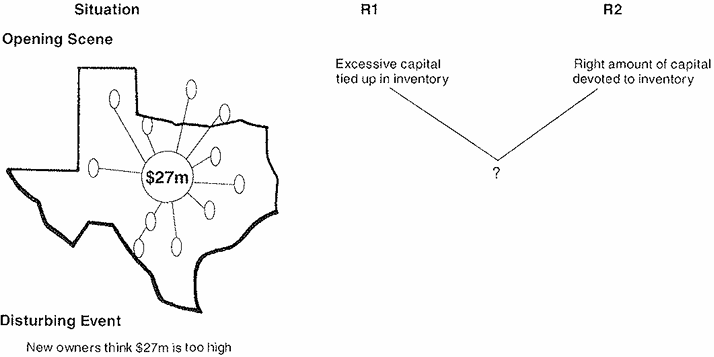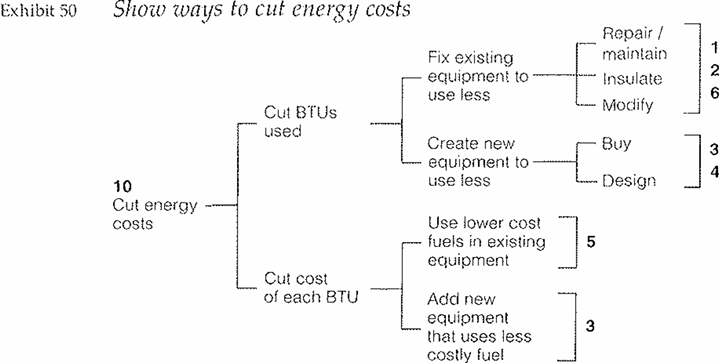


 Grammar
Grammar
 Tenses
Tenses
 Present
Present
 Past
Past
 Future
Future
 Parts Of Speech
Parts Of Speech
 Nouns
Nouns
 Verbs
Verbs
 Adverbs
Adverbs
 Adjectives
Adjectives
 Pronouns
Pronouns
 Pre Position
Pre Position
 Preposition by function
Preposition by function 
 Preposition by construction
Preposition by construction
 Conjunctions
Conjunctions
 Interjections
Interjections
 Grammar Rules
Grammar Rules
 Linguistics
Linguistics
 Semantics
Semantics
 Pragmatics
Pragmatics
 Reading Comprehension
Reading Comprehension|
Read More
Date: 2024-09-13
Date: 2024-09-15
Date: 2024-10-02
|
You can use this same technique of displaying the logical relationships between groups of activities to question the logic of what you've written. A good example of how to do so can be seen in analyzing the lists of so-called Key Issues. These were taken from a proposal to a company in Texas that distributed pipes and fittings to construction sites around the state.
The company purchased the products from suppliers, and stocked them in a central warehouse; this warehouse in turn supplied a dozen or so smaller warehouses in regions throughout the state. The company had just been taken over, and the new owners thought that an inventory cost of $27 million for the central warehouse was too high. In addition, because the central warehouse was frequently out of stock of some items, the outlying warehouses also ordered direct from suppliers, further increasing inventory cost.
Here again we have a very wordy, ugly, mediocre expression of a business message. And again its impenetrability results from the writer's lack of a clear image to be communicated, itself the result of a confused approach to the problem solving.
The first question to ask ourselves is, does the list really include "key issues"? And how do they relate to our definition of the problem? Strictly speaking, an issue is a question so phrased as to require a yes-or-no answer. Phrasing it in this form permits us to direct our analysis to a specific end product needed to prove or disprove our understanding of the causes of the problem.
Accordingly such questions as number two, "What level of inventory investment is necessary?" are not issues. Stated as an issue, the question would be "Is the present level of inventory too high?" or "Do we need as much inventory as we now have?" Given your understanding of the problem-solving process, you will be able to recognize these rephrasings as attempts to define how we will know when we have solved the problem.
The problem now is that the cost of the inventory at $27 million is thought to be too high (R1), and it should be instead some other number (R2). The first thing to establish is what that other number should be, so that we can judge whether in fact the present levels are too high.

Assuming that the figure is too high, we can use a tree diagram to identify the possible causes of its being too high. What does one do to create inventory at high levels? Perhaps this:

Now we can frame proper issues, which turn out to relate somewhat to points 2 and 4 in the issue list.
- Is the centralized management system placing orders properly?
- Is it keeping too much obsolete and slow-moving inventory?
What does all this tell us? First, that talking about issues here is misleading. Instead, what is being discussed is the process the consultant will follow to solve the client's problem. What is that problem? That his centralized system ties up too much working capital in inventory. He should probably be saying something like this:

In general, I don't believe there ever is a need for a section called "Issues,” especially in a consulting proposal. The issues, if any, will always derive from the analytical process to be used to solve the problem. So the issues, the process, and the end products of the study all turn out to be the same thing.
Indeed, l find thinking in terms of "issues" always to be nonproductive. Let me do one more example, to hammer home the value of using logic trees to reveal relationships. Here is another set of "issues," more confused if possible than the previous group. They are really questions meant to identify the alternative ways available to reduce the cost of energy consumed in a factory.
If you tried to diagram the alternative ways to reduce the cost of energy, you would get a choice diagram like Exhibit 50, where the numbers of the issues that relate to it have been inserted.

You can see that Issues 7, 8, and 9 simply don't relate to the subject. Issues l, 2, and 6 are related to fixing the existing equipment to use less, Issues 3 and 4 are related to creating new equipment to use less, Issue 5 speaks to using lower cost fuels in existing equipment, and adding new equipment that uses less costly fuel is touched on in Issue 3. Issue 10 refers to cutting energy costs altogether.
Remember, all groupings of ideas must have had their origin in an analytical activity of the mind. In situations where you are trying to solve a problem, the likelihood is that your groupings derived from one or another of the structures you created to guide your analysis. Matching your ideas to these structures can help you to verify their logical validity.
|
|
|
|
لصحة القلب والأمعاء.. 8 أطعمة لا غنى عنها
|
|
|
|
|
|
|
حل سحري لخلايا البيروفسكايت الشمسية.. يرفع كفاءتها إلى 26%
|
|
|
|
|
|
|
جامعة الكفيل تحتفي بذكرى ولادة الإمام محمد الجواد (عليه السلام)
|
|
|